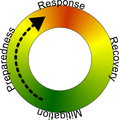Managing a Disaster - Four phases of success (Responding)
By Jamey PerkinsDownload this article in Adobe Acrobat Reader
Response to a disaster
The most important rule to remember when a disaster strikes is to follow your emergency plan, which should first require you to seek safety. However, if you are part of an emergency response team that has been called upon to aid in a disaster situation, the sequence of events becomes immensely more complicated.

Emergency situations are handled by various point of government and private response organizations. Ambulance Services, Fire Departments, Search and Rescue, Law Enforcement, and Hazardous Materials teams are just a sample of those which may respond to a crisis. One problem that can occur during large multi-departmental responses is that lack of continuity and organization among agencies can lead to confusion and lack of efficiency.
On April 1, 1979 the US created (FEMA) the Federal Emergency Management Agency by Presidential Order. Its goal was to coordinate the response to emergencies among federal, state, and local authorities. This began a new era in how emergency responses were handled, and started to create a forum that allowed for guidelines and standards to be written to better organize all branches of responders.
On November 25, 2002 the (DHS) Department of Homeland Security was created by the Homeland Security Act. The intention of this new division of government was to help consolidate various agencies that would be responsible for responding to emergency situations into a single government cabinet. Among those absorbed into this new branch was FEMA.
On March 1, 2004, Homeland Security Secretary Tom Ridge released a new framework by which overwhelming crisis situations would be handled. The National Incident Management System (NIMS) was a result of Homeland Security Presidential Directive (HSPD-5), and was created in an effort to better organize a more standardized response to emergencies by all levels of responders. This system covers all facets of a response, including preparedness and mitigation programs, and is designed to be used as an all encompassing readiness and response plan. With training programs in place, all personnel in federal, state, local, and private response agencies that may be called to respond to an emergency will be given until October 1, 2006 to complete the training.
Although the attention of responses to emergency situations has been in the forefront of many government discussions, much evidence still looms as to how effective our current methods really are. Surely there will always be room for improvement, especially due to changes in behaviors and trends in terrorism and natural disasters.
In 2005 FEMA came under extreme scrutiny for their response to Hurricane Katrina in the Gulf of Mexico. At the time, the responsibility of FEMA's actions lay on director Michael brown. Accusations of a slow response by the Federal Government, as well as the lack of education among responders, would eventually lead to Michael Brown being relieved of command of the Katrina response, and eventually his resignation. Although so many things went wrong during the response to the hurricane event, one major factor that could have played a key role is that responders had not yet had time to meet the training requirements set forth by NIMS. This could also partially be blamed on procrastination among agencies to administer training to their personnel.
In 2008, the National Response Framework (NRF) replaced the National Response Plan (NRP). Formerly, the NRP was focused largely on Federal roles and responses. The newly formed NRF is designed to create a sort of blueprint for all organizational and tribal approaches to emergencies and disaster. It outlines roles and responsibilities, response actions, preparedness structure, and resources for federal, state, local, tribal, and individual approach to crisis. It was formed on the backbone of the events that transpired during and after the World Trade Center Disaster on September 11, 2001 in New York City.
An effective strategy for responding to any crisis, no matter what the size, is the ability of those responding to communicate and to work together to accomplish a common goal. Learning from our mistakes in history often provides us with the knowledge and tools necessary for effectively handling and identifying events that will surely occur in the future.
Read the rest of the article
- What is a disaster
- The evolution of man and nature as a direct result of disaster
- Managing a Disaster - Four phases of success (Mitigation)
- Managing a Disaster - Four phases of success (Preparation)
- Managing a Disaster - Four phases of success (Responding)
- Managing a Disaster - Four phases of success (Recovery)
- Disaster Management - An organized structure in the midst of a chaotic event
- Disaster - An inevitable future

